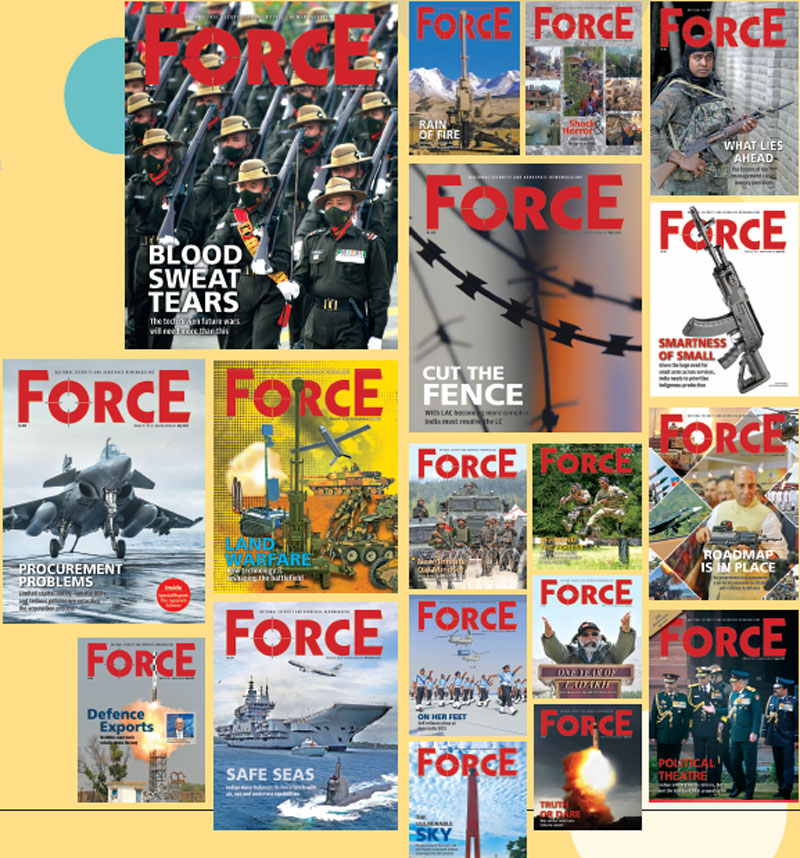Our scope has widened. Our focus has sharpened behoving a 19-year-old
Ghazala Wahab
One of the reasons for the enduring appeal of the Harry Potter series was that the characters of the novel grew up with the readers, and consequently both the story and the language grew in complexity. What’s more, the author J.K. Rowling wove in contemporary and politically challenging issues into the narrative raising the level from just a children adventure series to a commentary on society, democracy, diversity, resistance and the ever-present danger of complicity.

FORCE’s journey of 19 years has been a bit like this. On Independence Day 2003, when the magazine was born, it needed both handholding as well as a narrow focus so that it could build upon its core strength. Being an infant, it also needed linear ideas and tell them simplistically. We were conscious of the fact that FORCE was not just the first for us, but for our readers too. There had never been a magazine before on national security and defence in India.
A lot of people likened us to the Jane’s Defence Weekly. The comparison was flattering. But not accurate. The biggest difference was in the nature of our ambition. We aspired to mainstream issues of national security. Our target readership was not only the defence forces and the defence industry, but the general public—the people of India. We wanted them to get interested in matters of defence and security, because frankly everything stemmed from there. Though we didn’t quite articulate it in so many words, we understood that just as a secure periphery ensures a secure centre, the opposite was equally true. Hence, national growth, whether economic or social, hinged on the sense of security we had as citizens.
And so, we started with reporting on the Indian military and the paramilitary (now called the central armed police forces). We travelled, at our expense to different field areas, starting with the Line of Control for the first issue of FORCE, and wrote about the operational and tactical challenges and opportunities that the India military faced.
We took great pride in the fact that we were the only private magazine with access to military and the paramilitary to the extent that it was possible for us to visit their operational location, stay with the troops, as well as interview their chiefs, both in their offices and homes. From inside the fighter aircraft to the submarine, from India-China border personnel meeting point in Arunachal Pradesh to the heart of Maoist territory in Dandakaranya forest, from the narrow lanes of militants’ hotbed Sopore to the helicopter manufacturing unit of Hindustan Aeronautics Ltd, from the Border Security Force’s Officers Training Academy in Tekanpur to the Indian Naval Academy in Ezhimala, there has not been an aspect of India’s defence and security that FORCE has not covered through ‘on-the-spot’ reporting in its 19-year short life.
We introduced the readers to mainstream tropes like profiling the Services’ Chiefs; doing descriptive features like a day in the life of soldier on the LC; writing long-form obituaries on the fallen soldiers based on interviews with family, friends and buddies; featuring old battles with archival photographs, as well as a defence quiz!
Obviously, nothing remains static. It’s the rule of the nature. You are born. And you grow. If you don’t grow, you die. The good news is, we were growing issue after issue—intellectually. Our travels, our reporting, our informal interactions, our formal interviews all worked to not only broaden our perspective but chisel it too. We knew nothing was constant. The world was in a flux. The threats facing India were continuously stretching themselves and then stretching some more. Also, like an untreated abscess, they were sprouting in different parts of the nation. Worse, like shape-shifting ghouls they looked different at different times.
FORCE couldn’t remain oblivious to these. It was neither fair to our experience nor to our subscribers, most of whom have grown up with us. Our editorials have become more encompassing and more critical. Interestingly, even as our scope widened, our focus sharpened over the years. We understand what is important and what mere posturing.
The 75 years of India’s independence coincides with our 19th birthday. Time for whimsy, indulgences and impetuousness is over. We have to get critical about the business of national security. And that reflects in our editorial. After all, we have entered our 20th year. Congratulations to us.

